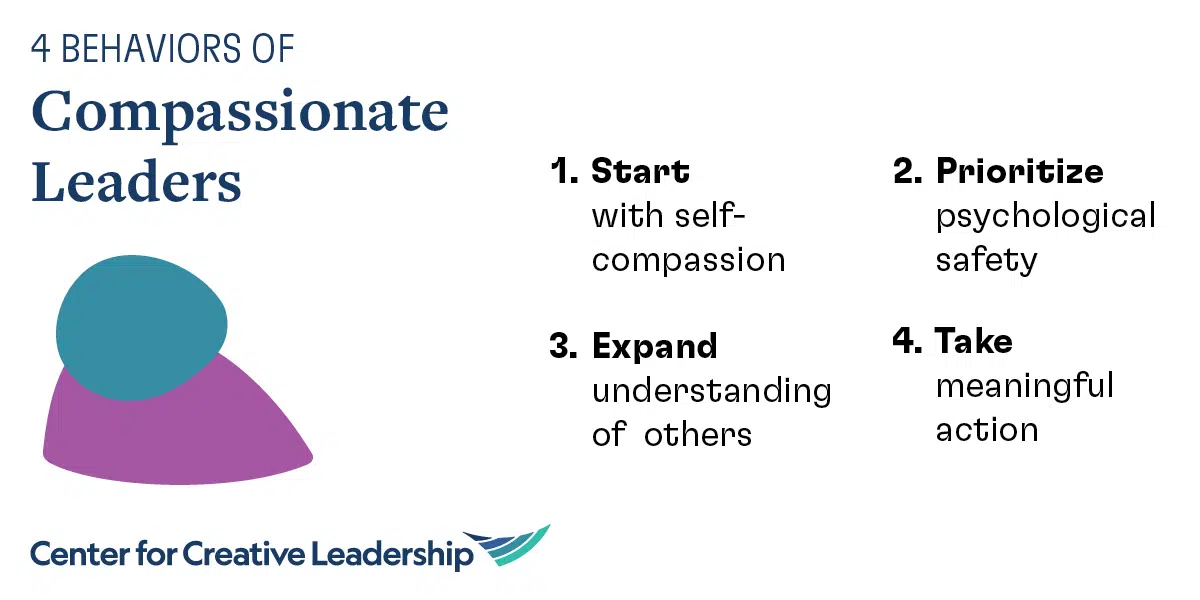Compassionate Leadership Is a Choice, and It’s All About Action
When faced with seemingly insurmountable challenges, we count on good leaders to take actions that pave a way forward for us all.
But better leaders know that success is about more than just their own personal competencies. Leadership is a social process, and to create shared direction, alignment, and commitment — the outcomes of leadership — they need a team of people who are able to function at their best.
At the core of leading others well? Compassionate leadership.
Compassion is at the heart of relationship-building, says Karissa McKenna, who is responsible for 3 of our core leadership programs, including our flagship Leadership Development Program (LDP)®.
At its broadest, compassion is an awareness of a person’s condition, coupled with genuine concern for that person and a willingness to take action to help. It’s about having the courage to walk alongside someone as they navigate a difficult time, a complex situation, or a persistent problem.
Truly compassionate leaders don’t merely lend a sympathetic ear or show empathy for everyone, and their goal isn’t just to solve the problems of their direct reports or take pain away from them.
Instead, compassionate leaders move beyond empathetic concern to take productive actions — supporting team members as they work through challenges and looking for systemic ways to reduce friction, making it easier for good people to do great work.
In short, compassionate leadership is about being willing to apply your influence and power to help create a more even playing field for others.
Why Is Compassionate Leadership Important?
Compassionate leaders are more effective leaders, because they’re able to strengthen trust on their teams and increase organizational collaboration, while decreasing turnover rates, research shows.
The ever-changing context of today’s workplace is challenging. Both internal and external forces are constantly shifting — on our teams, in our industries, and even in our personal lives. All of these forces can come into play, which is why you have to have compassion — both for yourself and for your team. As leaders demonstrate compassion toward themselves and others, they expand their entire team’s capacity to handle future challenges.
Compassion is one of the most powerful acts of leadership available to us, and it often shows up in the smallest of ways. “We see it in those moment-by-moment acknowledgements of what’s hard, what hurts, what is joyous, exciting, or disappointing,” McKenna says.
Most importantly, compassionate leaders acknowledge that their colleagues are more than any specific trauma they’ve endured or challenge they may be facing. In other words, they recognize that someone may be dealing with a particular hardship, but also that they have unique strengths. Compassionate leaders are able to see and acknowledge the whole person in context and seek to grow that person (not just solve their problems). In doing so, they uncover hidden talents and find new ways to leverage the skills and contributions of others.
Ultimately, compassionate leadership changes an entire organization’s culture, yielding greater cooperation and grace for all. Employees trust their leaders and each other, giving others the benefit of the doubt. As a result, senior leaders feel more comfortable taking bold, courageous actions. And when their people feel heard and sense that their perspectives and experiences are valued, they’re better able to support those bold actions, which benefits the entire enterprise.
Compassion Is Different From Empathy
Compassion Vs. Empathy, Explained
It’s important to note that compassionate leadership is more than just feeling empathy for everyone.
What’s the difference between compassion vs. empathy? Compassion is a lot like empathy, in that both attempt to understand how another person feels. And empathy in the workplace is certainly good to have. But simply feeling what someone else is feeling can be painful, and not very productive.
That’s because research has found that when we witness the pain and suffering of someone else, networks in our brains are activated which trigger and amplify similar negative emotions, making us more likely to experience emotional burnout.
For example, imagine an emergency room physician who feels overwhelming empathy toward their ER trauma patients. The doctor is then both less able to fulfill a unique and important role — providing expert help in a moment of need — and more likely to experience personal burnout. “What the physician needs isn’t empathy, but compassion — the ability to recognize the suffering and care for the person, quite literally in this case!” McKenna says.
In contrast to empathy, compassion has been found to involve a different set of neural networks and increases positive feelings, resilience, and the ability to overcome distress in challenging situations. In other words, compassion increases our likelihood of behaviors that take action to help others, whereas empathy alone does not.
“If you sit with another person’s emotions and ‘get stuck in their suffering’ without doing something about it, it can lead to burnout and broader organizational problems — both for you and your direct reports,” McKenna says. That’s why in chaotic times, when managers feel they can barely handle their own emotions, much less those of their direct reports, leaders should focus on compassion vs. empathy.
Behaviors of Compassionate Leaders
How to Show Compassionate Leadership: 4 Steps
During everyday interactions, leaders have many opportunities to incorporate compassionate leadership behaviors. Read on to learn how to recognize these opportunities and use them to make a difference on your team and in your organization’s culture.
1. Start with self-compassion.
Don’t overlook the power of showing compassion to yourself. Before you can extend compassion to others, make sure you’ve done the same for yourself. Research has found that leaders perform better when they show self-compassion, and it’s actually more predictive of goal attainment than self-confidence, according to one study.
“At least a third of the leaders we’ve seen in our leadership programs profoundly need more compassion for themselves,” McKenna says. “They’ve gone through a lot and they’re beating themselves up about their missteps. But imperfections are something to notice and care for.“
The key, McKenna says, is the ability to tease apart the small truths in what you’re telling yourself from “the big lie.” Perhaps you’re upset that your presentation didn’t go as planned; That didn’t go as well as I hoped is true. But I’ve lost all credibility with senior management likely isn’t.
“The small truth is almost always something you can deal with, learn from, and grow through. But the big lie can be paralyzing and costs a tremendous amount of energy.” Leaders who focus on the big lies instead of the small truths are too hard on themselves. By not showing themselves compassion for their mistakes, they miss a chance to learn from their experiences and try again.
- TIP: The way you talk to yourself really matters. Whether you’re speaking out loud, thinking in your head, or just jotting things down in a journal, harness the power of positive self-talk to improve your mental health and your leadership effectiveness. One trick is to talk to yourself in the second person (use “you,” not “I”). When you make that shift, you’ll probably automatically speak to yourself the way you might speak to a valued friend. (You’ll be honest, but kinder).
Another thing we see with our participants are struggles with work/life balance and resilience in handling stress, uncertainty, and setbacks. We remind them that taking time out for self-care and rest isn’t weakness. Recharging is important, because when we create space to notice and care for our imperfect selves, we also increase our ability to do that for others. Becoming a more holistic leader will enable you to be a more resilient, effective, and compassionate leader too.
- TIP: You must make time for wellness to reach your full potential. And it’s good to model taking time for yourself for others on your team, as it underscores that you and your organization understand the importance of wellbeing and leadership.
2. Prioritize psychological safety.
You can lay the groundwork for compassionate leadership by helping to create a culture that invites people to bring their full, authentic selves to work. “Anytime you have a group or team trying to accomplish something together, each person brings a whole life’s worth of experiences and perspectives, strengths and weaknesses, which can be tapped,” says McKenna.
When there’s psychological safety at work, employees feel comfortable speaking up, asking questions, sharing concerns, and respectfully disagreeing. When individuals feel able to share missteps without fear of retribution and energized instead of stifled by their differences, increased openness to diversity of thought leads to more risk-taking and greater innovation and collaboration. You get a multiplier effect, and the entire team benefits.
- TIP: As you learn from your own failures or disappointments, freely share those lessons with your team. This demonstrates self-compassion, shows that you value learning from mistakes, and challenges your direct reports to see mistakes as an opportunity for growth. You also create an environment where people know that honesty and candor are appreciated. And don’t forget to acknowledge successes and celebrate wins.
Leader attitudes and behaviors have a major impact on how psychologically safe their teams feel. Politeness and kindness really matter, not only to the person directly involved, but to the whole climate of the team and their direct reports too. Research shows that supervisor incivility has a negative impact on psychological safety 2 levels down in the organization. And more than half of first-time leaders (52%) in a large global CCL study said that it was not safe to make mistakes or take risks, suggesting that a lack of psychological safety is a barrier holding these emerging leaders back from making bigger contributions at their organizations by stepping up to larger leadership roles.
- TIP: Hopefully it goes without saying, but show kindness in the workplace!
3. Expand your understanding of others.
A curious mindset is fundamental to compassionate leadership. First, leaders must notice the challenges colleagues and direct reports are facing, and then they can ask questions to learn more and expand their scope of understanding.
“We cannot show compassion to another person unless we have truly listened to that person,” McKenna notes. Leaders don’t need to have all the answers, but when they use the practice of active listening, it conveys that they care. It’s important to listen for understanding, of both the facts and the feelings and values behind the facts, to learn more about where your people are coming from and what matters to them.
When you listen with curiosity, within an environment that is psychologically safe, it opens the door to another powerful tool — asking open-ended questions that convey caring and connection. Asking the right questions shows that leaders value others’ perspectives and can provide insight into why everyone on the team may not be aligned and committed — and what’s holding them back from moving together in a shared direction.
- TIP: Something as simple as noticing how someone is doing, asking them about it, and then listening for facts, feelings, and values in their answer can be a powerful leadership practice. Even saying something like, I see you’re overwhelmed and I wonder how I can help can really demonstrate compassionate leadership. Show kindness when colleagues disclose worries, hardships, or setbacks, but don’t immediately try to fix things or solve their problems. Ask good questions that help people view dilemmas from a different angle. Use the information you gain to help influence what you do next.
4. Take meaningful action.
Compassionate leadership isn’t merely providing a sympathetic ear. Simply having empathy for everyone without taking any meaningful action can actually be detrimental, both to individuals and the organization as a whole. Even if managers are great listeners when their employees speak up about something, they won’t feel truly listened to if their leaders don’t then act on what they heard, our researchers have found. This is because when employees share a concern, they’re doing so with the hope it will lead to positive organizational change; and if that doesn’t happen, they don’t feel heard and are then less likely to speak up in the future.
Compassionate leaders aren’t passive and do not accept excuses. When leaders hold their people accountable, they demonstrate that they trust them to follow through on their commitments. “We also don’t want the rest of the team to absorb all the problems when one team member isn’t accountable,” says McKenna.
Instead of stepping in to solve another person’s problems, leaders can use their power and influence to provide direction and structure. As a result, empowered employees have the tools they need to work through challenges and emerge as stronger problem-solvers.
- TIP: After you’ve listened, ask how you can support in resolving the issue. Work toward a mutual understanding of what the other person needs, how they might be able to address their needs themselves, and any additional resources that could be helpful. Also, listen closely for what you as a leader could do to support the other person as they work through the problem, or whether there are ways you could help to remove obstacles in their way that might be creating needless friction. Are there ways you could use the power of your leadership role to make your team or organization more inclusive or equitable by helping to remove the roadblocks others face?
Compassionate Leaders Are Better Leaders
Compassionate leaders move beyond empathetic concern to take productive actions. If they don’t, organizations will never be as strong or productive as they could be.
At CCL, we believe in helping leaders and organizations cultivate cultures that truly support everyone — ensuring people are better than just okay. We’ve created a downloadable collection of leadership resources on compassion, wellbeing, and belonging with actionable tips gleaned from our research.
The ever-changing context of today’s workplace is challenging. Both internal and external forces are constantly shifting — on our teams, in our industries, and even in our personal lives. All of these forces can come into play, which is why you have to have compassion — both for yourself and for your team. Compassionate leadership is also a key element of fostering belonging at work, which influences job satisfaction and performance.
When managers are compassionate leaders towards both themselves and others, they become more effective — as individuals, on their teams, within their organizations, and even impacting their entire communities. Compassionate leaders come to work as whole people, and work alongside others, enabling them to be whole people too, to create shared value for the collective.
Ready to Take the Next Step?
Take a meaningful step toward increasing compassionate leadership in your workplace by starting a conversation with colleagues on your team or at your organization. Download Our Compassionate Leadership Conversation Starter Guide now.
Get our complimentary resource for (better) leadership today for help facilitating a productive conversation with your team on what compassion looks like at your organization.










